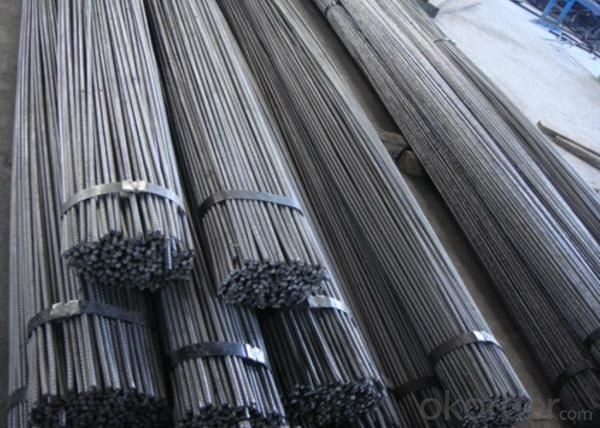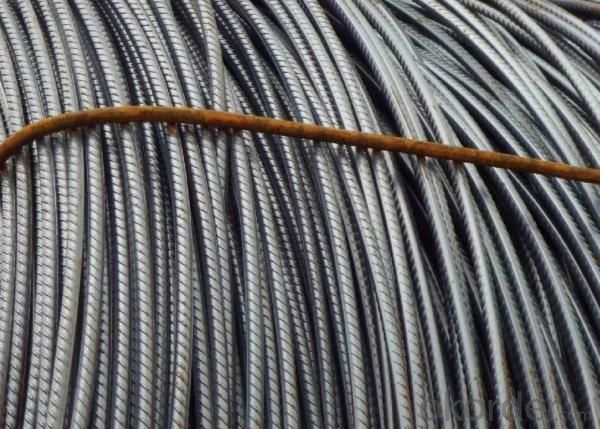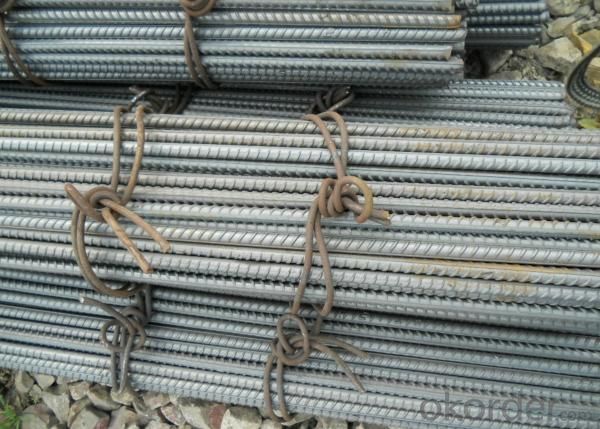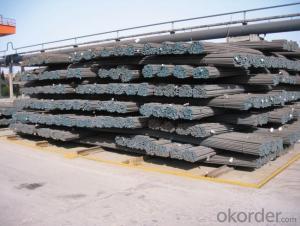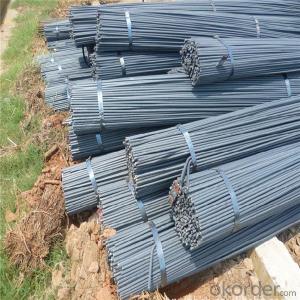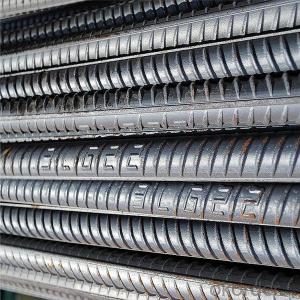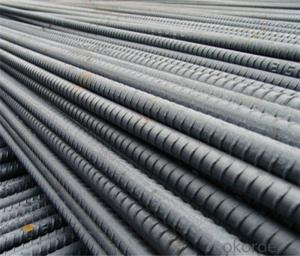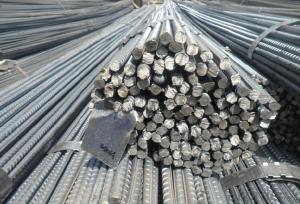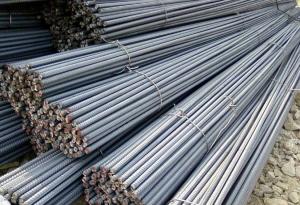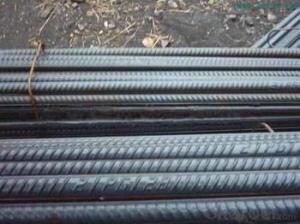Construction Deformed Steel Rebar
- Loading Port:
- China Main Port
- Payment Terms:
- TT or LC
- Min Order Qty:
- 25MT m.t.
- Supply Capability:
- 800000Tons m.t./month
OKorder Service Pledge
OKorder Financial Service
You Might Also Like
Specifications of Construction Deformed Steel Rebar:
Standard | GB UK USA | HRB335 HRB400 HRB500 G460B, B500A, B500B,B500C GR40, GR60 | |
Diameter | 6mm,8mm,10mm,12mm,14mm,16mm,18mm,20mm, 22mm,25mm,28mm,32mm,36mm,40mm,50mm | ||
Length | 6M, 9M,12M or as required | ||
Packing | Export standard packing: wrapped by wire rod in bundles | ||
Each bundle weight | 2-3MT, or as required | ||
Inspection | Accept the third party inspection | ||
Type | Hot rolled steel rebar | ||
Brand name | DRAGON | ||
Chemical Composition: (Please kindly find our chemistry of our material based on BS4449 as below for your information)
BS4449 G460B | Chemical Composition | ||||
C | Mn | Si | S | P | |
0.18 | 0.35 | 0.14 | 0.025 | 0.25 | |
Physical capability | |||||
Yield Strength(N/cm²) | Tensile Strength(N/cm²) | Elongation (%) | |||
625 | ≥460 | 18 | |||
BS4449 500B | Chemical Composition | ||||
C | Mn | Si | S | P | |
0.24 | 0.45 | 0.16 | 0.05 | 0.31 | |
Physical capability | |||||
Yield Strength(N/cm²) | Tensile Strength(N/cm²) | Elongation (%) | |||
650 | ≥500 | 19 | |||
Deformed Steel Rebar in factory
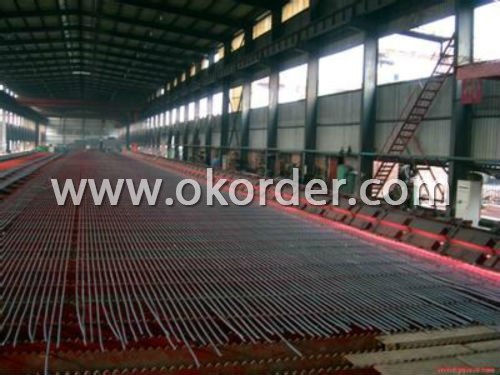
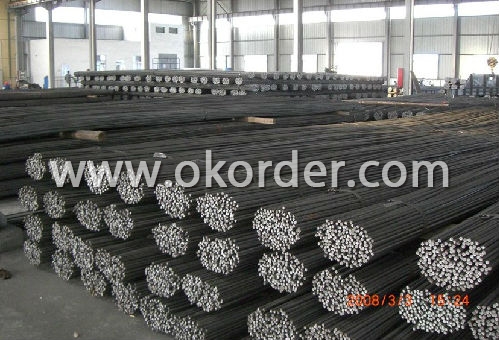
Usage and Applications of Construction Deformed Steel Rebar:
Deformed bar is widely used in buildings, bridges, roads and other engineering construction. Big to highways, railways, bridges, culverts, tunnels, public facilities such as flood control, dam, small to housing construction, beam, column, wall and the foundation of the plate, deformed bar is an integral structure material. With the development of world economy and the vigorous development of infrastructure construction, real estate, the demand for deformed bar will be larger and larger..
Packaging & Delivery of Construction Deformed Steel Rebar:
Packaging Detail: products are packed in bundle and then shipped by container or bulk vessel, deformed bar is usually naked strapping delivery, when storing, please pay attention to moisture proof. The performance of rust will produce adverse effect.
Payment terms: TT payment in advance or Irrevocable LC at sight.
Trade terms :FOB, CFR, CIF
Delivery Detail: within 45 days after received advanced payment or LC.
Note:
1. Our products are produced according to national standard (GB), if not, supply according to national standards (GB) or agreement as customer required.
2. Other Grade and Standard Deformed Steel Bar we can supply:
Grade: GR40/GR60, G460B/B500A/B500B/B500C,BST500S
Standard: ASTM, BS, DIN
The Minimum Order Quantity of these products is high, and need to be confirmed.
3. We can not only supply Deformed Steel Bar; if you need anything about building materials, please contact us for further information.
4. Please send us your detail specifications when inquire. We will reply to you as soon as possible. We sincerely hope we can establish a long stable business relationship.
- Q: How do steel rebars affect the ductility of reinforced concrete?
- Steel rebars greatly enhance the ductility of reinforced concrete by providing a strong and flexible reinforcement. The rebars absorb and distribute tensile forces, preventing cracks from forming and enhancing the overall strength and durability of the concrete structure.
- Q: Can steel rebars be used in structures with high electromagnetic shielding requirements?
- Yes, steel rebars can be used in structures with high electromagnetic shielding requirements. Steel is a highly conductive material, which means it can effectively block electromagnetic waves. Therefore, when properly installed and grounded, steel rebars can provide significant electromagnetic shielding for structures.
- Q: What are the different methods of fixing steel rebars in formwork?
- There are several methods of fixing steel rebars in formwork, including tying the rebars using wire or metal ties, using rebar spacers or chairs to hold the rebars in place, using rebar couplers to join rebars together, and using mechanical or adhesive anchors to secure the rebars to the formwork.
- Q: Can steel rebars be used in structures with high resistance to creep?
- Yes, steel rebars can be used in structures with high resistance to creep. Steel rebars are commonly used in reinforced concrete structures and provide strength and durability to the overall structure. Creep is the gradual deformation of a material under constant stress over time. While steel does exhibit some creep, it is considered to have a low creep rate compared to other materials such as concrete or timber. Additionally, the use of rebars in reinforced concrete structures can help distribute the load and minimize the effects of creep by adding stiffness and reducing the overall stress on the concrete. Therefore, steel rebars can be effectively used in structures with high resistance to creep when designed and installed properly.
- Q: What is the difference between the material of steel thread and its use?
- Main uses: widely used in housing, bridges, roads and other civil engineering construction.Main origin: the manufacturer of thread steel is mainly distributed in North China and Northeast China
- Q: How do steel rebars affect the overall maintenance requirements of concrete structures?
- Steel rebars, being strong and durable, enhance the structural integrity of concrete structures. By providing reinforcement, rebars help in distributing the load and increasing the resistance to cracking and tension. This leads to reduced maintenance requirements for concrete structures as they become more resistant to wear and tear, environmental factors, and potential structural failures.
- Q: How are steel rebars protected from theft during construction?
- Steel rebars are commonly protected from theft during construction through various security measures. These may include storing them in locked and secured areas, implementing surveillance systems, using GPS tracking devices, employing security personnel, and maintaining strict inventory management. Additionally, marking the rebars with identification numbers or unique markings can also help deter theft and aid in recovery efforts if stolen.
- Q: Can steel rebars be used in sports arena construction?
- Yes, steel rebars can be used in sports arena construction. Steel rebars are commonly used in the construction industry for their strength, durability, and ability to reinforce concrete structures. In sports arena construction, steel rebars are often utilized to reinforce the concrete foundations, beams, columns, and other structural elements of the building to ensure its stability and withstand heavy loads.
- Q: How do steel rebars affect the overall durability of marine structures?
- Steel rebars play a crucial role in enhancing the overall durability of marine structures. Due to their high tensile strength and corrosion resistance, steel rebars provide structural stability and prevent the degradation of marine structures caused by environmental factors such as saltwater, waves, and harsh weather conditions. One of the main challenges faced by marine structures is corrosion, as the constant exposure to saltwater can significantly weaken the structure over time. Steel rebars, often coated with anti-corrosive materials such as epoxy or galvanized coatings, act as a protective layer against corrosion. This coating prevents the penetration of saltwater and other corrosive agents, ensuring the longevity of the marine structure. Furthermore, steel rebars are known for their high tensile strength, which allows them to withstand the tremendous forces exerted by waves and currents. These rebars provide the necessary reinforcement to the concrete used in marine structures, preventing cracks or failure due to excessive loads. This reinforcement enhances the structural integrity of the marine structure, making it more resilient against external forces. Moreover, steel rebars offer flexibility in design and construction, allowing for the creation of complex and robust marine structures. With the ability to bend and shape rebars as needed, engineers can design structures that are better suited to withstand the unique challenges posed by the marine environment. This flexibility also facilitates the construction process, making it more efficient and cost-effective. Overall, steel rebars significantly contribute to the durability of marine structures by providing corrosion resistance, enhancing structural stability, and enabling innovative design solutions. Their presence ensures the longevity and reliability of marine structures, allowing them to withstand the harsh conditions of the marine environment for extended periods.
- Q: How do steel rebars affect the overall load distribution of concrete structures?
- Steel rebars play a critical role in the load distribution of concrete structures. They enhance the overall strength and durability of the concrete by providing reinforcement. When concrete is poured, it is strong in compression but weak in tension. Steel rebars are embedded within the concrete to counterbalance this weakness and distribute the load more evenly. The presence of steel rebars helps to prevent cracks and structural failures by absorbing and distributing the tensile forces exerted on the concrete. As the load is applied to the structure, the steel rebars effectively transfer the tension forces to the surrounding concrete, which is highly resistant to compression. This load transfer mechanism results in a more balanced distribution of forces throughout the structure. Furthermore, the use of steel rebars increases the overall stiffness of the concrete structure. By resisting deformation, the rebars help to maintain the structural integrity and prevent excessive deflection under load. This is particularly important in large-scale concrete structures such as bridges, high-rise buildings, and dams, where the load distribution needs to be carefully managed to ensure stability. In summary, steel rebars significantly influence the load distribution of concrete structures by reinforcing the concrete and enhancing its tensile strength. They work in synergy with the concrete to evenly distribute and transfer the load, preventing cracks and structural failures. The combination of steel rebars and concrete creates a robust and reliable structural system capable of withstanding the applied loads and ensuring long-term safety.
1. Manufacturer Overview
| Location | Hebei, China |
| Year Established | 2009 |
| Annual Output Value | Above US$ 500 Million |
| Main Markets | Southeast Asia; East Asia; Middle east |
| Company Certifications | ISO 9001:2008 |
2. Manufacturer Certificates
| a) Certification Name | |
| Range | |
| Reference | |
| Validity Period |
3. Manufacturer Capability
| a) Trade Capacity | |
| Nearest Port | Tianjin; |
| Export Percentage | 40%-60% |
| No.of Employees in Trade Department | 21-60 People |
| Language Spoken: | English; Chinese |
| b) Factory Information | |
| Factory Size: | Above 850,000 square meters |
| No. of Production Lines | Above 5 |
| Contract Manufacturing | OEM service offered |
| Product Price Range | high; average |
Send your message to us
Construction Deformed Steel Rebar
- Loading Port:
- China Main Port
- Payment Terms:
- TT or LC
- Min Order Qty:
- 25MT m.t.
- Supply Capability:
- 800000Tons m.t./month
OKorder Service Pledge
OKorder Financial Service
Similar products
Hot products
Hot Searches
Related keywords



